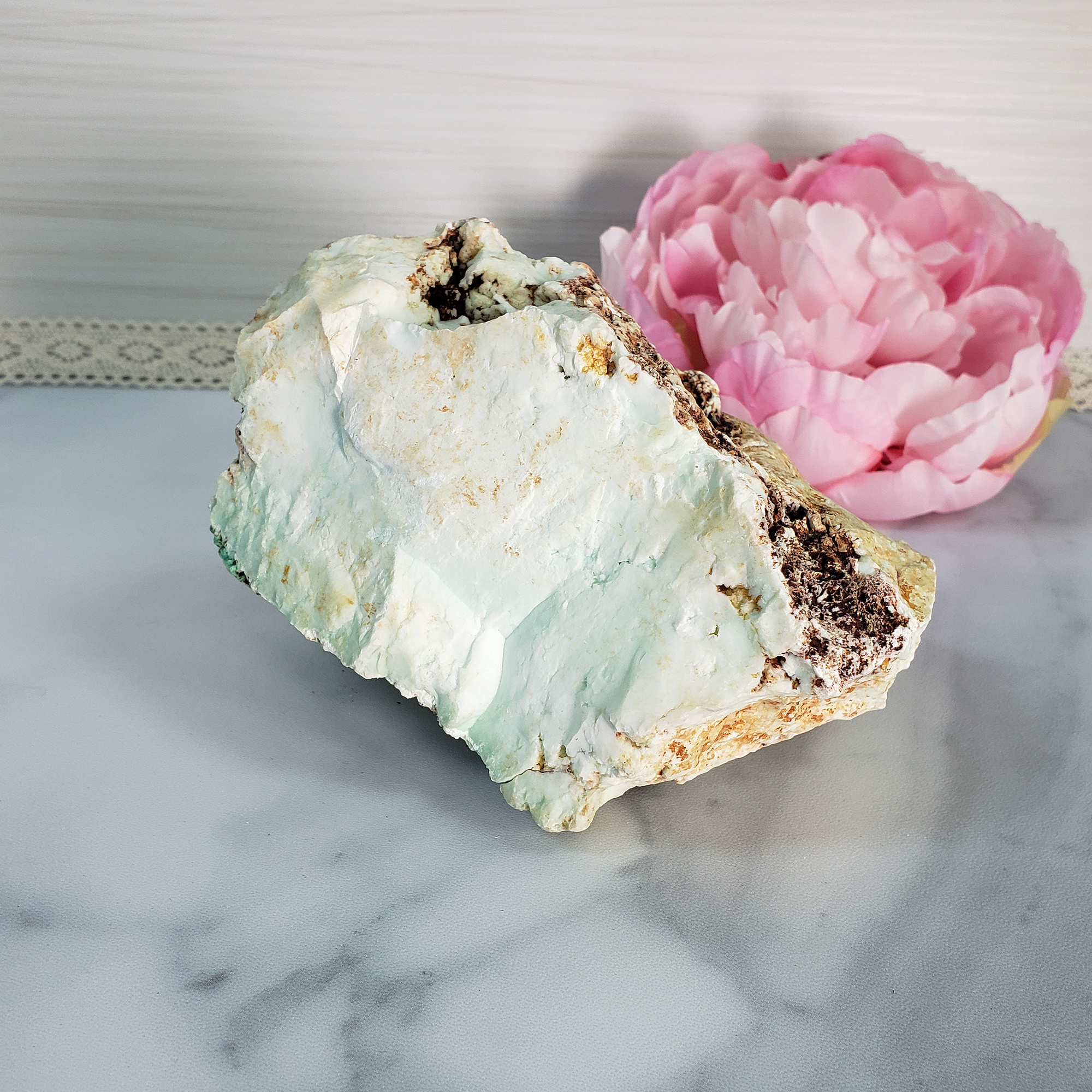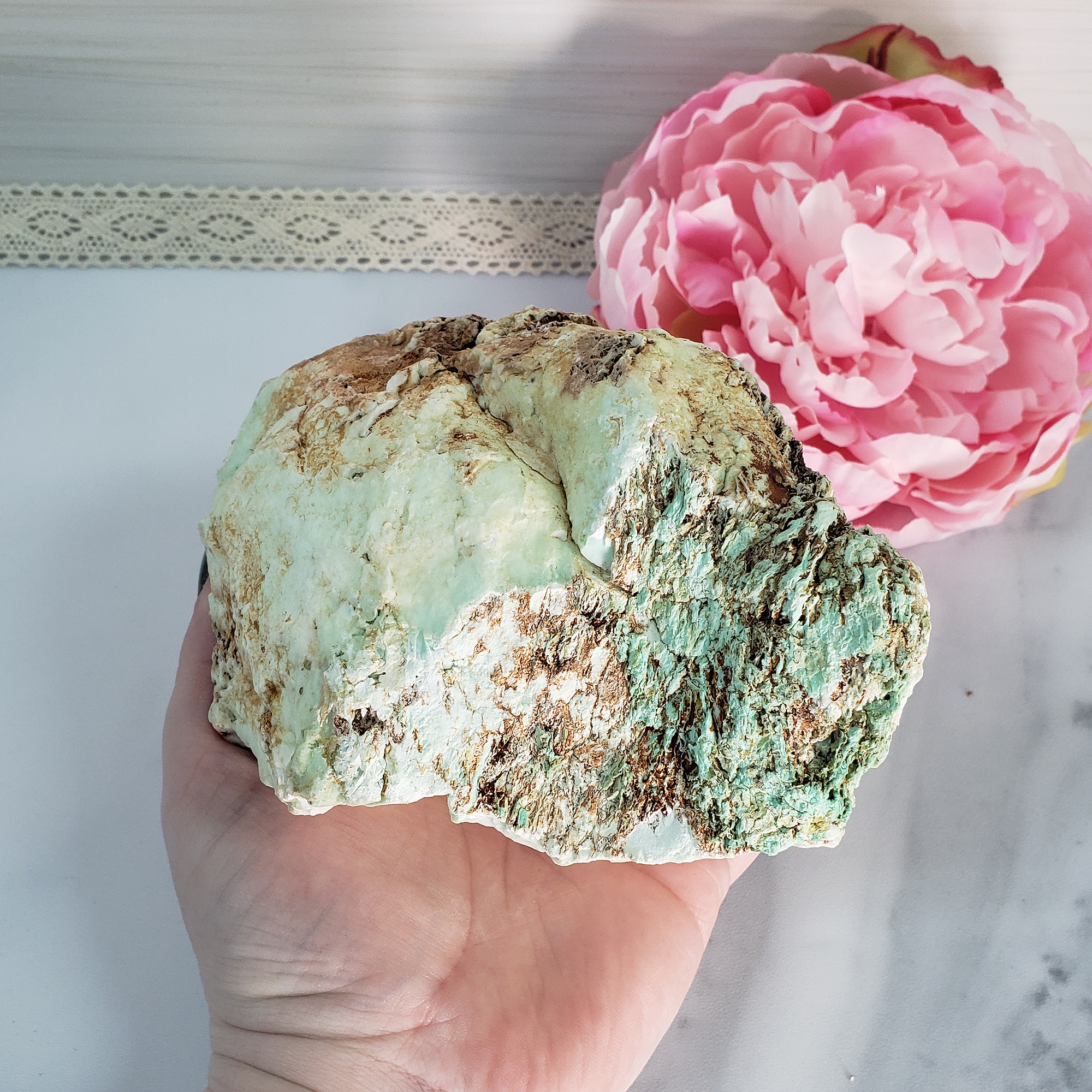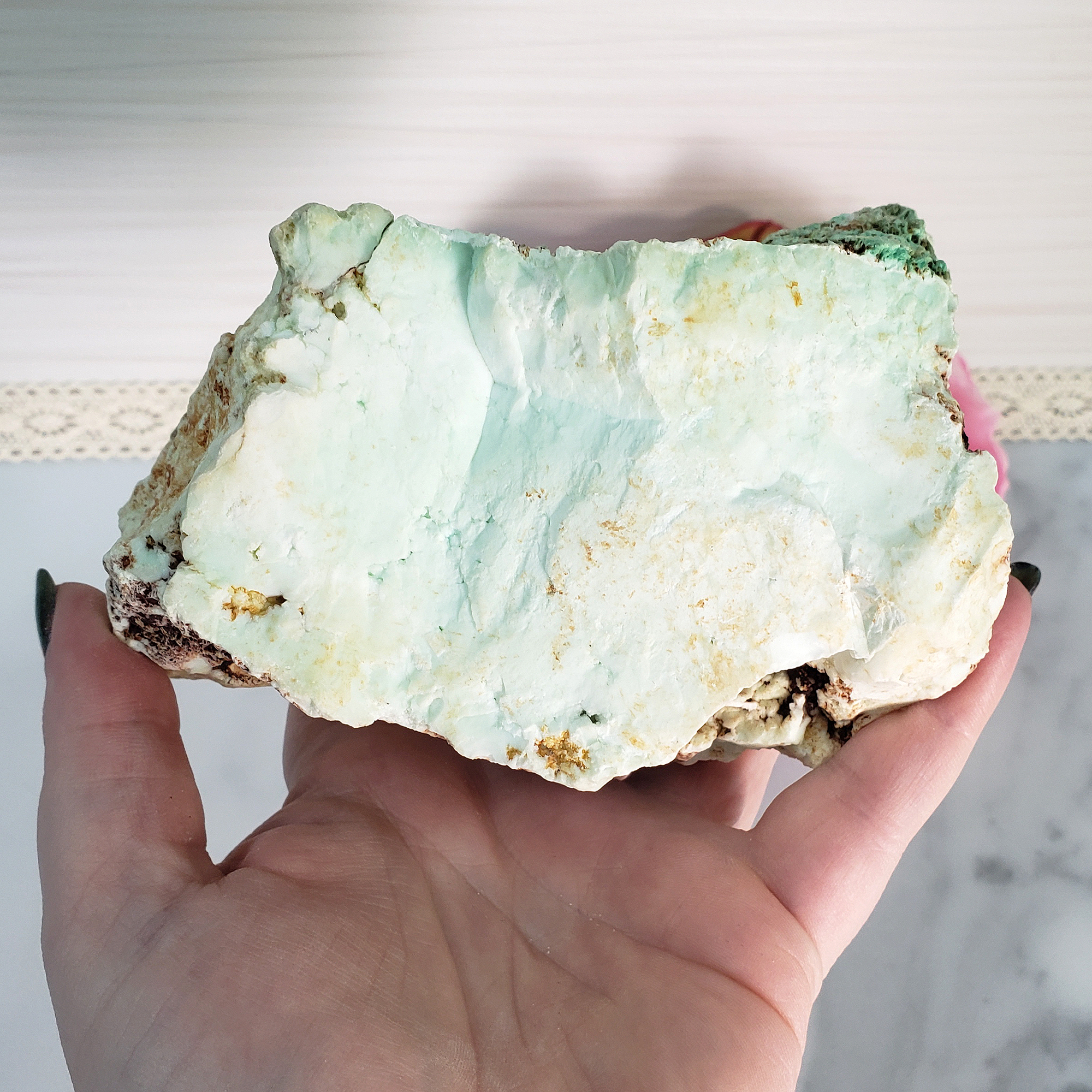What is Citron Chrysoprase?
Citron Chrysoprase, sometimes referred to as Lemon Chrysoprase, Yellow Chrysoprase, Citron Magnesite, or Lemon Magnesite, is a natural gemstone with a delicate ivory to yellow-green shade. It should be noted that although this gem is commonly given the moniker of Chrysoprase, it's actually a form of Nickeloan Magnesite! The mineralogical differences between the two are quite stark, since Magnesite is a member of the Calcite group with a Mohs hardness of approximately 3 - 4.5, while Chrysoprase is a form of Chalcedony with a Mohs hardness of approximately 6 - 7.
Understanding Chrysoprase:
-
Chemical Composition:
Chrysoprase is a form of chalcedony with the chemical formula SiO2, classified under silicon dioxide. It's part of the silicates group, specifically tectosilicates, and belongs to the Trigonal/Hexagonal crystal system. -
Mineralogical Attributes:
Renowned for its translucent bright apple green hue, chrysoprase owes its color to the presence of nickel. This gemstone is the rarest and most valuable among chalcedonies and was historically mistaken for jade. -
Identification Tips:
Be cautious of clear or white chalcedony that is often dyed green and sold as chrysoprase. The dyed stones usually have a color that appears too dark and uniform to be genuine. -
Symbolic Connections:
Chrysoprase is considered a secondary birthstone for Libra, associated with the Heart and Upper Heart chakras. It aligns with the elements of Water and Earth, and in Traditional Chinese Medicine (TCM), it corresponds to the element of Wood.
This gem's allure and unique characteristics make it a standout choice for collectors and enthusiasts alike, offering both beauty and a touch of mystique.
Just from these simple differences, you can see that these two stones should not be mistaken for one another, and yet the misnomer of Citron Chrysoprase has stuck. Today, many collectors still use this term to refer to Nickeloan Magnesite, which is why we use this name as well in our listings.
The Meaning and Properties of Citron Chrysoprase / Lemon Magnesite
Lemon Magnesite is a gem for inspiring altruistic actions, compassion, and a connection to both the Higher Self and the Universal Consciousness. Resonating with the Heart Chakra and Crown Chakra in tandem, this light yellow crystal is used to promote self-love, happiness, focus, and mindfulness.
It is a delightful gem for those in relationships, since it is known for inspiring attentive, generous behavior. If you are looking to build a stronger connection with the divine, engage your empathic abilities, and strengthen your humanitarian efforts, Lemon Magnesite makes a fabulous support stone.
Chakra and Element Associations
Chakras:
- Heart Chakra
- Crown Chakra
For a broader understanding of chakra associations, Lemon Magnesite complements the Heart and Upper Heart Chakras. It aligns beautifully with emotional balance and spiritual growth.
Elements:
- Water
- Earth
In the realm of Traditional Chinese Medicine (TCM), the element of Wood is also significant, adding layers of connectivity and grounding to its energy profile.
Whether you're seeking to deepen your spiritual practice or enhance your emotional well-being, Lemon Magnesite offers a harmonious blend of chakral and elemental influences to support your journey.
Crystal Healing Practices with Lemon Chrysoprase
Lemon Magnesite is a gem for inspiring altruistic actions, compassion, and a connection to both the Higher Self and the Universal Consciousness. Resonating with the Heart Chakra and Crown Chakra in tandem, this light yellow crystal is used to promote self-love, happiness, focus, and mindfulness.
But what makes Lemon Magnesite truly special is its ability to soothe turbulent emotions and redirect focus towards positivity. In times of emotional turmoil, this gem acts as a gentle guide, encouraging you to release feelings of anger and embrace a more optimistic outlook. It serves as a reminder to celebrate what you have and to cultivate gratitude, much like a ‘glass half full’ companion.
For those in relationships, Lemon Magnesite is known for inspiring attentive, generous behavior. It encourages empathy and understanding, helping you to connect more deeply with loved ones. If you are looking to build a stronger connection with the divine, engage your empathic abilities, and strengthen your humanitarian efforts, Lemon Magnesite makes a fabulous support stone.
Whether you're navigating personal challenges or seeking spiritual growth, Lemon Magnesite stands as a steadfast ally, guiding you towards a more enlightened and balanced state of being.
What is the Rarity & Value of Chrysoprase Compared to Other Chalcedonies?
Chrysoprase stands out as the most rare and prized among all chalcedony varieties. Its scarcity and demand have historically led to it being confused with the more commonly known jade. While chalcedonies in general vary in abundance and price, chrysoprase commands higher attention and value due to its unique verdant hue and limited availability.
How to Cleanse Citron Chrysoprase / Lemon Magnesite
Because Lemon Magnesite is an extremely soft stone, we must advise against cleansing this gem with water, as long-term submersion will cause damage to this crystal. We always suggest charging and cleansing gemstones with a Selenite bowl or tile, or with Full Moonlight, as these methods will not cause damage to your gems. Smoke Cleansing with Sage, Incense, or dried herbs is another safe way to spiritually cleanse your Lemon Magnesite.
The Historical Significance of Lemon Chrysoprase
Lemon chrysoprase, a gemstone with a name derived from Greek, meaning "golden green," has captivated civilizations for centuries. Its allure and legendary status date back thousands of years, but it gained pronounced recognition during the Middle Ages.
Ancient texts, including the Bible, reference chrysoprase, highlighting its longstanding influence. Prominent historical figures such as Jean de Mandeville and Hildegard von Bingen extolled its qualities. Their writings emphasize its reputed ability to enhance eyesight and soothe emotions, particularly by quelling anger and promoting harmony.
In summary, lemon chrysoprase has not only been a subject of aesthetic admiration but also regarded as a stone of healing and tranquility throughout history.
How is Lemon Chrysoprase Formed Geologically?
Lemon chrysoprase is a fascinating mineral that finds its origins within specific geological processes. It primarily forms from its parent mineral, magnesite, which commonly exists in magnesium-rich rocks known as metamorphic rocks. However, magnesite can also emerge within certain igneous rocks, those derived from once molten material.
The formation of lemon chrysoprase involves a critical interaction between magnesium-rich fluids and calcite-bearing rocks. When these elements come together, they can give rise to formations such as citron chrysoprase or citrone magnesite. This process underscores the essential role magnesium plays in creating these distinctive varieties of magnesite, including the vibrant lemon chrysoprase. By understanding these geological conditions, one can appreciate how nature crafts such unique and striking stones.
Where is Lemon Chrysoprase Found?
Lemon chrysoprase is predominantly discovered in the rich grounds of Western Australia. The chief areas known for this vibrant gemstone include Yerilla and Lake Disappointment. Among these, Lake Disappointment stands out as the primary source for this unique mineral.
How to Distinguish Dyed Chalcedony from Genuine Chrysoprase
Distinguishing dyed chalcedony from authentic chrysoprase involves a keen eye and a few specific techniques. Here's how you can spot the differences:
-
Color Intensity and Uniformity
- Genuine chrysoprase boasts a vibrant apple-green hue, but natural variations in color are common. Dyed chalcedony often has a darker, more uniform color that seems unnatural. If the stone's color appears too consistent, it may be artificial.
-
Translucency and Texture
- Examine the stone's translucency. Genuine chrysoprase is semi-translucent and may vary slightly in different lighting. In contrast, dyed stones often appear overly opaque or uniformly translucent.
-
Magnification
- Use a jeweler's loupe to inspect the surface of the stone. Genuine chrysoprase may show minor inclusions and a natural texture, while dyed versions often have an overly smooth surface lacking natural imperfections.
-
Price Comparison
- Authentic chrysoprase is typically more expensive due to its scarcity and desirable aesthetics. A significantly lower price could suggest a dyed alternative.
-
Reputable Certification
- Purchase from reputable dealers who can provide certification or documentation verifying the stone's authenticity. This documentation often states whether any treatments or dyes have been applied.
By scrutinizing these aspects, you can better differentiate between dyed chalcedony and genuine chrysoprase, ensuring authenticity and value in your purchase.
How is Chrysoprase Connected to Nature and the Natural World?
Chrysoprase is a gemstone that resonates deeply with the earth's energy. Often considered a bridge to the natural world, this stone embodies the nurturing essence of nature. Its soothing presence can evoke the feeling of being cradled by the earth itself.
A Conduit to Earth Energy
The vibrant green hue of chrysoprase is symbolic of its connection to life and renewal. It mirrors the lush expanses of forests and meadows, making it a powerful ally for those seeking to connect with nature’s vibrancy. Many practitioners believe that this stone acts as a conduit to Gaia's energy, fostering a harmonious relationship between humans and the planet.
Attracts Nature Spirits
Chrysoprase is reputed for its ability to draw nature spirits and elemental forces. This makes it an ideal choice for those engaged in activities involving nature energy or communication with the Fairy realm. Its appeal to these spirits suggests a profound alignment with the natural world.
Benefits of Working with Chrysoprase
-
Emotional Support: It provides a comforting, grounding sensation reminiscent of a gentle touch from the earth.
-
Enhancing Meditation: Using chrysoprase during meditation can deepen your connection to the environment, enhancing your appreciation for the natural world.
-
Nature-Based Practices: Ideal for rituals or practices focusing on earth energy, it helps enhance the experience by aligning your energies more closely with those of nature.
Final Thoughts
Chrysoprase isn’t just a stone; it's a link to Mother Earth’s embrace. By incorporating it into your spiritual or meditative practices, you may find a renewed sense of peace and a deeper bond with the natural world.
What Factors Influence the Price of Lemon Chrysoprase?
When assessing the price of lemon chrysoprase, several key factors come into play. Understanding these can help both buyers and sellers navigate the market more effectively.
Color Quality
Foremost among these is the gemstone's color. Lemon chrysoprase is prized for its bright and intense yellow-green hue. Stones that display a clear, vibrant color typically command higher prices than those with dull or inconsistent tones. The purer and more striking the color, the more valuable the gemstone becomes in the eyes of collectors and jewelers.
Clarity and Overall Quality
Clarity is another critical factor, as it significantly affects the stone's appearance and value. High-quality lemon chrysoprase with minimal inclusions or imperfections is more sought after, and thus, more expensive. In gemstones, a clearer stone often equates to higher perceived quality.
Origin and Rarity
The stone's origin can also influence its price. Lemon chrysoprase is chiefly mined in Western Australia, particularly in areas like Yerilla and Lake Disappointment. This geographic specificity can contribute to its rarity in global markets, potentially increasing its value outside these regions. Additional costs related to transporting and taxing these stones from mine to market can further affect pricing.
Market Demand
Market trends and demand play substantial roles as well. If lemon chrysoprase becomes popular within the jewelry industry or for other specific uses, heightened demand could drive up prices. Trendy gemstones typically enjoy a spike in market value.
Comparison with Other Gemstones
Although lemon chrysoprase is often more affordable than precious stones like diamonds or emeralds, prices for higher-quality specimens can still be significant. Generally, semi-precious stones like lemon chrysoprase range from a few dollars per carat to over $50 per carat, depending on their color, clarity, and cut.
In summary, the price of lemon chrysoprase is a reflection of its color, clarity, origin, market demand, and comparison to other gemstones. By understanding these factors, one can make more informed buying or selling decisions in the gemstone marketplace.
The Connection Between Lemon Chrysoprase and Aries
Lemon chrysoprase, while not an officially recognized birthstone, holds a mystical allure for those born under the Aries zodiac sign. Many astrology enthusiasts are drawn to this vibrant gem, as it's believed to have a spiritual resonance with the fiery Aries.
A Spiritual Bond
For Aries individuals, known for their bold and dynamic nature, lemon chrysoprase is thought to offer a harmonious balance. This stone is said to encourage growth, inspire positivity, and cultivate serenity, aligning perfectly with the adventurous spirit of Aries. The gem's reputed properties are thought to complement the proactive and enterprising energy of this zodiac sign.
Personal Beliefs and Value
Even without empirical proof, many people cherish lemon chrysoprase for its perceived benefits. Its reputed ability to foster a sense of well-being and calm makes it a popular choice among those who seek a deeper connection with their astrological identity.
In essence, the relationship between lemon chrysoprase and Aries is one steeped in personal belief and spiritual symbolism, valued by many for its potential to enhance the natural characteristics of those born under this sign.
Historical Uses of Chrysoprase for Healing and Protection
Chrysoprase, a captivating gemstone characterized by its golden green hue, has been utilized throughout history for its perceived healing and protective properties. Although not prominently recognized for these qualities until the Middle Ages, this stone has a rich historical lineage.
Middle Ages Accounts
During medieval times, chrysoprase was genuinely embraced for its talismanic properties.
Recommendations by Historical Figures
-
Camillo Leonardo , a scholar of the time, echoed the sentiment that chrysoprase had a special connection with vision, suggesting its primary virtue was to nourish the eyes. -
Hildegard von Bingen , a renowned 12th-century mystic and healer, extensively documented the stone's therapeutic uses. She recommended placing chrysoprase on the skin to alleviate gout symptoms. Furthermore, she advocated for its use in calming anger, suggesting that wearing it around the throat could help mitigate harsh words. According to her, the stone was also believed to clear poisons, prevent seizures, and assist in exorcisms, making it easier to dispel negative forces.
Given these historical perspectives, chrysoprase was indeed considered a multifaceted stone, sought after for its diverse range of healing and protective capabilities.







